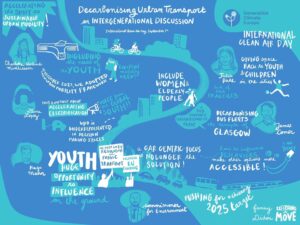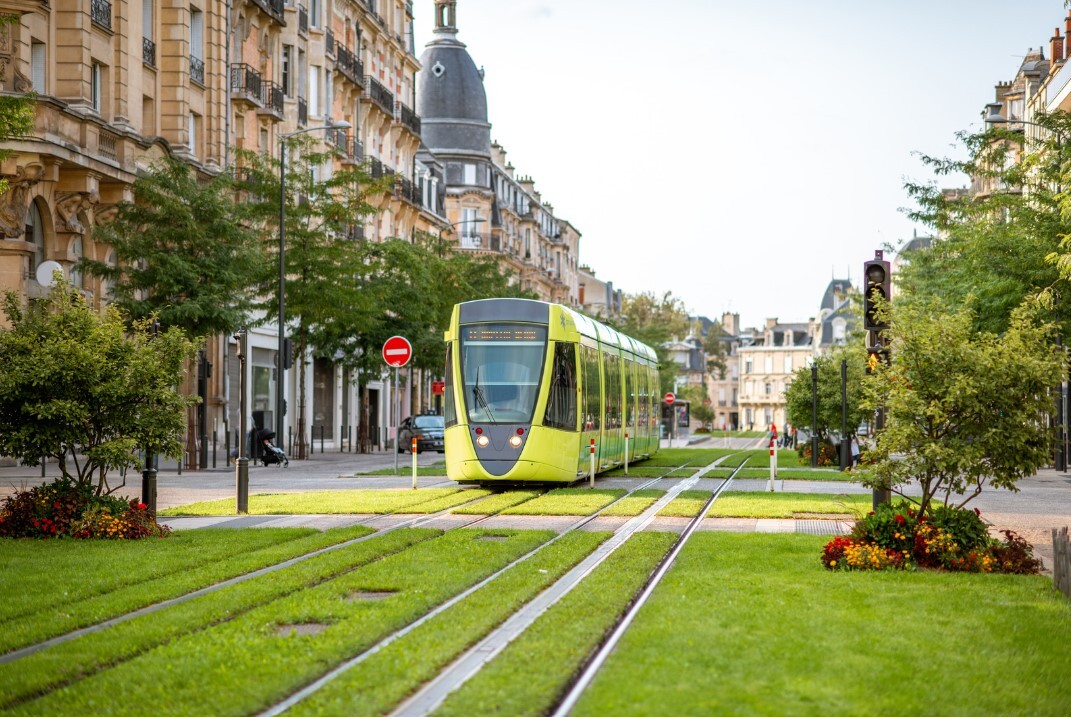The event
On 7 September 2022, International Clean Air Day, Generation Climate Europe (GCE) hosted the online dialogue ‘Decarbonising Urban Transport: An Intergenerational Discussion’ with five speakers from diverse stakeholder groups, a youth audience, and special guest Virginijus Sinkevicius, European Commissioner for Environment. We were joined by the following speakers:
- Charlotte Nørlund-Matthiessen, Policy Advisor on green and smart mobility at the cabinet of the Commissioner for Transport Adina Ioana Vălean;
- Laura López, Sustainable Mobility Junior Officer at ICLEI;
- Julia Dade, Member of the National Board of BUNDJugend;
- James Comer, Government, and External Affairs Lead for ZeroCarbon at Hitachi;
- and Hugo Mann, Urban Fleets Campaigner at the Clean Cities Campaign.
The dialogue brought to the table different perspectives on current challenges and solutions for decarbonising urban mobility at the EU level. Discussions took place in the form of a breakout room in which participants were asked to reflect on urban mobility realities and challenges they face in their daily lives, panel discussions, and a Q&A. It was also an opportunity for the GCE Clean Mobility team to present our new policy paper on the EU initiatives on decarbonising urban mobility including recommendations, which can be found here.
The challenges
The discussion started with breakout rooms where participants used Google Maps to see which transport options were shown to a place they frequently visited. This was a way to see urban mobility challenges on a personal level. Many common themes emerged such as the unreliability of trains, the lack of safety for bicycles, and the cost of trains compared to cars.
In the panel discussion, Laura López then took this conversation on challenges from the personal to the policy level, when discussing her work on the electrification of bus fleets in the Global South. She emphasised that there is not enough spotlight on service users, who are mainly students, the elderly, women, and those with low-incomes. This leads to overcrowded services, inconvenient routes, and high costs because policy-makers are middle-aged men and not service users. The right people need to be involved in the decision-making process. Laura highlighted that ‘electrification is not a silver bullet’ but that we need holistic thinking.
Decarbonising under capitalism
Hitachi works on decarbonising their fleets and claims to focus on the whole lifecycle of their vehicles. James Comer spoke about how Hitachi works to present delivery fleet companies with a decarbonisation package that acknowledges profit and loss as the main incentives. In this system, he emphasised how crucial it is for government measures to shift behaviour, such as UK financing that encourages fleet decarbonisation and the inclusion of electric vehicles in the London congestion charge. He stressed that companies’ entire way of thinking needs to change. Currently, vehicles are used, run into the ground, and dumped. With electric vehicles and the potential scarcity of batteries, a circular economy must be adopted. For example, the aviation industry needs batteries at 90% health, whereas cars can use them at 70% health. Thus, they can be reused for different purposes and eventually used for energy storage.
Why youth must be part of urban mobility discussions
The discussion presented little doubt about the importance and advantages of including youth perspectives in discussions and decision-making on the future of urban mobility in the EU. Julia Dade emphasised that the needs of young people have not been taken into account and that cities have been “remodelled to fit cars, but not the people living in them”. She stressed that, ultimately, young people are the ones who will have to live in cities exposed to the climate crisis. We thus need to ensure they are liveable and sustainable for the long-term. Upon being asked if there were any best practices of how local authorities involved youth in decarbonisation or smart city planning, Dade expressed that she had not come across any but was eager to know about them. Using the example of playground cages in Berlin, Dade spoke about the need to “reclaim cities” from cars, air pollution, and insecure traffic by promoting the creation of greener, open and safe spaces, as well as better and more accessible public transport and bike lanes for all people; Especially children, because “why can’t cities be their playgrounds?”.
The power of youth campaigning
Hugo Mann, who works on implementing campaigns to bring about net-zero mobility, spoke encouragingly about the power of youth to mobilise and create change in politics. He said that young people are effective message carriers, especially as we are at the ‘vanguard [of shaping our futures]’ and have a unique voice to put pressure on, and question elected representatives about their plans to tackle the climate crisis. Even if your activism is apolitical, there is power in demanding action from different candidates running to be elected. Mann also noted the importance of being visible beyond social media, i.e. on the ground. Not only that, but it is an advantage to have young people involved in campaigns. “From a political point of view […] people listen to young people more. […] If you have a coordinated, vocal, impactful youth presence in any campaign you run, and it’s targeted correctly, I think that’s extremely effective.”
It was encouraging to hear Mann emphasise that, even if not at the EU level, important improvements can already be done by organising and campaigning at local, regional, and national levels.
EU initiatives
As a European Commission representative, Charlotte Nørlund-Matthiessen spoke about EU urban mobility initiatives:
- 2021 EU Urban Mobility Framework– guidance for cities, including Sustainable Urban Mobility Plans (SUMPs) which aim to tackle congestion, emissions, safety, and noise, and emphasise active mobility.
- Zero emission targets for taxis, ride-sharing services, and last-mile delivery.
- Multimodal hubs.
- EU funding for infrastructure projects.
And initiatives to involve the youth:
Nørlund-Matthiessen also talked about the Commission’s work to enable Multimodal Digital Mobility Services, i.e. apps that combine all transport options, give directions, and an entire journey in a single ticket. For this to happen, companies must release their data. As shown in the breakout room discussion, the inability of Google Maps to consider active transport or the easiest route, and the extra cost of transfer tickets need to change now. Everyone wants the simplest option, as James Comer said, whether they are corporations or individuals. That needs to be done in the most sustainable way.
Keep feeding the flame
Virginijus Sinkevicius, European Commissioner for Environment, provided final remarks. He spoke about Fit for 55, the Urban Mobility Framework, and the Commission’s ultimate objective of having 100% zero emissions for new vehicles by 2035. While acknowledging that it is not an easy task, he also offered words of encouragement that the youth voice is important for steering politics. The Commissioner believes that with our resources and commitments we can keep feeding the flame of environmentalism. The only way to deliver real change is to keep pushing.
Conclusion
GCE will continue to push for change and has published a policy paper, including recommendations, which were shared with participants:
- We need regulations, more funding, and better infrastructures for public transport, cycling, and walking;
- We need all cities to develop a sustainable urban mobility plan;
- We need stronger emissions targets for cars;
- We need regulation on zero-emission vehicle quotas for delivery fleets;
- And the EU needs to create space for young people as leaders in EU decision-making.
The event was concluded by closing remarks and a presentation of the live sketch that Fanny Didou had been working on throughout the event.


